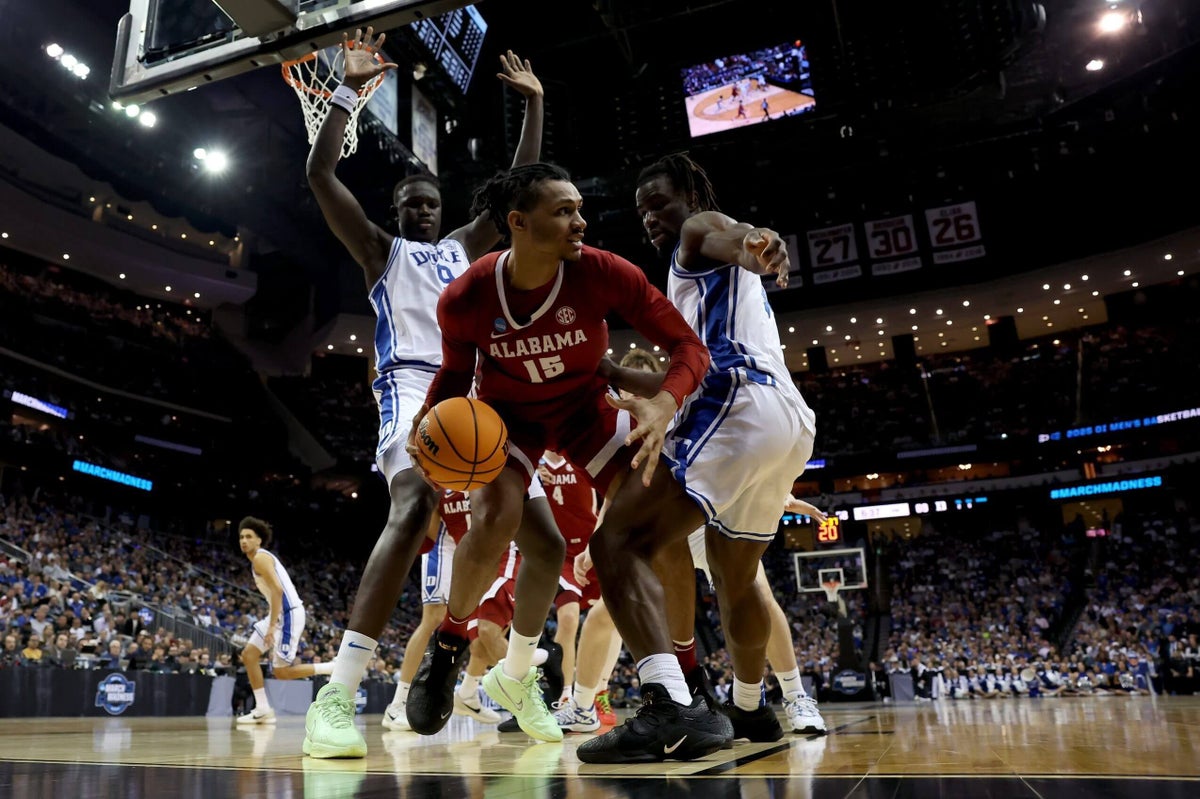The Athletic has live coverage of Auburn vs. Michigan State in the Elite Eight of the Men’s NCAA Tournament
NEWARK, N.J. — With 6:39 separating Duke from the Final Four berth it’s been chasing all season, Jon Scheyer huddled his team and took a deep breath.
Whatever he said during the penultimate media timeout of No. 1 Duke’s Elite Eight bout against No. 2-seeded Alabama would help decide the game: either the message that sent the Blue Devils to San Antonio … or the most misread moment of Scheyer’s three-year tenure.
“It’s our time, right f—ing now. Right f—ing now!” Scheyer barked Saturday at the five sets of eyes sitting in front of him. “This is our game.”
And soon enough, it was.
Because from that timeout on, Alabama scored only seven points. The Tide had arguably the most prolific offense Duke faced all season, which two days ago orchestrated one of the truly historic offensive efforts in the hallowed history of March Madness. Duke, on the other hand? It dropped a bowling ball on the gas pedal, just as Scheyer had hoped, ballooning its then-nine-point lead to as many as 20 for an 85-65 victory. Kon Knueppel led all scorers with 21 points, and star Cooper Flagg’s 16 points, nine rebounds and three assists helped him earn East Region Most Outstanding Player.
All things considered, Flagg wasn’t at his best most of Saturday. The freshman shot 6-of-16, and his four turnovers were his most since Jan. 25 at Wake Forest, when he had seven. But that’s what teammates like 7-foot-2 center Khaman Maluach — 14 points, nine rebounds, two blocks — and Knueppel are for: to pick up the slack on the rare day when the future No. 1 pick is merely solid, not superhuman.
“Everybody just coming into their role, doing their own, and just doing their job,” Flagg said, “is kind of what’s got us here.”
With the win, Duke advances to the program’s 18th Final Four — its first since 2022 and first under Scheyer, who also won national titles with the Blue Devils in 2010 (as a player) and 2015 (as an assistant coach).
The Blue Devils will play the winner of Sunday’s South Regional final between Houston and Tennessee next Saturday. They became the second No. 1 seed to clinch a Final Four spot, after Florida did so earlier Saturday. They got where they’d always believed they were headed with a talent like Flagg’s for one March only.
And that timeout was why.
“It can either be a game and all of a sudden, they’re on your heels — or you can get that extension,” Scheyer told The Athletic afterward from deep in the Prudential Center. “We’ve talked a lot about the inflection points. … Sometimes when you think about it as an eight-minute game, you don’t treat the precious possessions the way that you should at that moment. That’s what I was trying to get across.”
Clearly, message received.
“We realized we had to dig down deep and get more stops,” Maluach said. “Keep on getting stops, and then try to eliminate fouls (that) put them on the line so that the clock stops, and eliminate 3-pointers.”
Duke did all of the above down that final seven-minute stretch, the fifth-best defense in the country (per KenPom’s adjusted efficiency rankings) fully clamping down as it had all season. Alabama’s subsequent nine possessions after that timeout consisted of four missed layups, three turnovers and one missed free throw, before Alabama guard Mark Sears eventually broke the drought with a free throw with 2:47 to play.
That “cut” Duke’s lead to 19. Ballgame.
“We had a shot there. I think it was a nine-point game with the under-eight media,” Alabama coach Nate Oats said. “Then they went out on a 13-0 run — and the game was over.”
In many ways, though, Duke’s defense in the game’s final minutes was just more of the same. More of what already carried the Blue Devils to ACC regular-season and tournament titles, to the No. 1 ranking in the country and the No. 1 seed in the East Regional.
And at this rate, with only 80 minutes at most left in this season, that defense may be what delivers Scheyer’s squad to a sixth national championship banner.

Cooper Flagg scored 16 points Saturday against Alabama, but the Blue Devils didn’t need more from the star freshman, who scored 30 points in the Sweet 16 win over Arizona. (Vincent Carchietta / Imagn Images)
In hindsight, it almost feels foolish to ever have questioned Duke’s defensive aptitude. But given Alabama’s offensive explosion on Thursday against BYU, the question entering Saturday’s regional final was whether Oats’ team’s high-octane offense could be controlled. The Crimson Tide had, after all, canned an NCAA Tournament record 25 triples against the Cougars in the Sweet 16, looking every bit like their Final Four form from a season ago.
But instead, Alabama’s dismal offensive night — finishing the game shooting 23-for-65 (35.4 percent) overall and 8-for-32 from 3 (25 percent) — will be another footnote in Duke’s march to San Antonio. Oats’ team also entered Saturday averaging 13.7 fast-break points per game — the 18th most in America, per CBB Analytics — but was held to just eight for the evening.
That clearly was a point of emphasis for Scheyer and his staff, given his message in seemingly every single huddle: “Get our asses back, play our f—ing pace and do what you do.”
You can only imagine how many times people around Duke’s program heard something of that ilk during the 36 hours or so between the Sweet 16 and Elite Eight.
“I don’t even know what the outside of New Jersey looks like,” assistant coach Emanuel Dildy said. “We’ve been in the (hotel) ballroom meeting. Constant meetings. Constant staff meetings, constant team meetings … but at least we’re still playing.”
And despite the game’s epic billing, it looked like that might be the outcome from the onset. Flagg drained a top-of-the-key 3 on the team’s very first possession, the dynamite to Duke’s 15-5 run out of the gate. And while Alabama eventually settled in somewhat, that initial cushion proved pivotal to Duke’s wire-to-wire win, and its 46-37 halftime edge before that.
Duke’s offense entered Saturday night averaging 94 points in its first three tournament games, and that’s what hit first. Duke faced little resistance and shot 56.3 percent in the first half, making just as many 3s as Alabama (five) but on 10 fewer attempts: nine compared to the Crimson Tide’s 19.
Had Sears been hitting at the same scintillating rate as he did in the Crimson Tide’s Sweet 16 blowout over BYU, things might’ve gone differently. But the waves of defenders Duke threw at the All-American stymied Sears’ typical impact, relegating him to a scoreless first 17:43 of the game that included as many turnovers (three) as shots. Sears finally got a middy to fall minutes before the break, but it was obvious that Duke’s length — as the tallest team in the country, per KenPom, with no rotation players under 6 feet 5 — was just as much of an impediment as it was all season.
“It’s not really something that we haven’t done before,” Duke guard Caleb Foster said. “Contest every shot, don’t get strung out too far and (don’t get) riled up if they hit a few.”
There’s a reason why Scheyer and one of his closest friends in basketball, Boston Celtics general manager Brad Stevens, agreed on the best college roster-building philosophy back in the preseason: There’s no substitute for length.
As Duke returned to the court for the second half, Flagg’s mother, Kelly, said out loud what Duke fans in their living rooms nationwide were surely thinking: “100 more minutes, that’s all I want.”
Twenty down, 40 to go — and then, maybe, another 40 for all the marbles.
When Alabama opened the second half 1-for-7, failing to whittle the deficit, it became a matter of time until Duke’s confetti cannons erupted. And even when Duke struggled offensively at times in the second half, the Blue Devils’ ability to get to the charity stripe more than kept Alabama at bay. They shot 19-for-22 from the line for the game, including 14-for-16 in the second half.
The Crimson Tide never got it closer than six points in the second half, and even that was only because of Alabama’s similar free-throw prowess; Oats’ team shot 10 of its 14 total free throws in the second half. Which is why, in that same huddle with 6:39 to play, Scheyer’s main warning was simple: “They are automatic free-throw shooters.”
Alabama made one free throw the rest of the game: Sears’, when the outcome was already long decided.
Compare that with Duke’s game-sealing 13-0 run on both sides of that penultimate media timeout, a door-closing sequence punctuated by Flagg’s floater in front of Duke’s bench.
And now the Blue Devils are two games away from college basketball immortality.
(Top photo of Alabama’s Jarin Stevenson and Duke’s Sion James and Khaman Maluach: Elsa / Getty Images)





